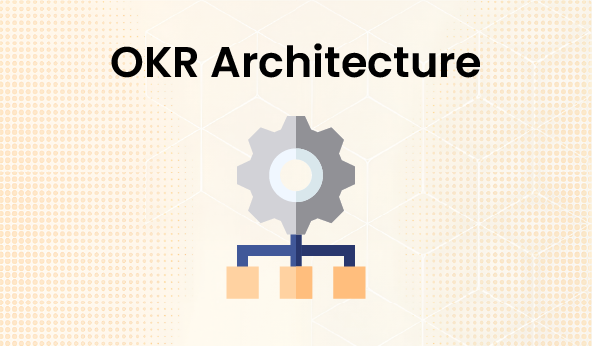5 Building Blocks of an AI Strategy Framework for Enterprise OKRs
Most enterprises have OKRs. Fewer have a system that keeps them alive.
The distance between strategy and execution often lies in how organizations interpret data, not how they set goals.
An AI strategy framework for enterprise OKRs closes that gap by turning intentions into measurable, machine-readable actions.
It connects objectives to real performance signals, aligns teams with clarity, and keeps outcomes visible across leadership layers.
Below are the five building blocks that define how AI gives OKRs structure, accountability, and forward motion.
Top 5 Building Blocks of an AI Strategy Framework for Enterprise OKRs
1. Strategic Clarity: Translating Vision into Measurable Context
An effective AI strategy framework for enterprise OKRs starts with precision, not aspiration.
AI cannot interpret ambition; it understands structure. To work, goals must be written in a way that both leaders and systems can read.
When objectives are defined through measurable indicators, the framework can detect drift, trace causality, and connect every target to enterprise outcomes.
For example, replacing “improve retention” with “raise the returning-customer ratio by 12 percent in two quarters” gives AI something it can monitor, test, and refine.
At scale, enterprise AI planning uses this clarity to synchronize strategy across divisions, so every OKR feeds into a single source of truth.
The result is not a static list of goals but a living alignment model where data and intent move in the same direction.
2. Connected Data Infrastructure: Building the Operational Core
Every AI strategy framework for enterprise OKRs depends on how well its data moves.
AI is limited to aligning what it can perceive. Even the most intelligent model will misinterpret performance if marketing, finance, and human resources all report through separate platforms.
Connected data infrastructure syncs these silos' metrics.
APIs and automated data pipelines allow the framework to pull live updates from HRIS, CRM, and project tools, creating one transparent operational layer.
This visibility strengthens data governance for AI by letting enterprises track how numbers evolve across teams and time.
It’s not about more data; it’s about trusted data that keeps every objective verifiable.
When the information architecture is consistent, strategy stops being theoretical and becomes observable.
3. Predictive Alignment: Turning OKRs from Reactive to Anticipatory
In most enterprises, OKRs confirm what already happened.
An AI strategy framework for enterprise OKRs changes that rhythm; it spots shifts before they surface in reports.
AI doesn’t wait for the quarter to end; it reads motion in real time.
It detects stalling campaigns, budget fatigue, and team data that reveal potential.
Awareness offers leaders time to refocus, alter resources, or change expectations before performance declines.
The finest AI KPI tracking is an early sense of direction, not an alert system.
OKRs become a living feedback network where strategy may evolve as rapidly as the business it guides.
4. Governance and Transparency: Making AI Accountable
No AI strategy framework for enterprise OKRs succeeds without trust.
Executives must know how AI arrives at its conclusions and whether its data logic can be verified.
Governance gives that assurance, not as bureaucracy, but as visibility.
Each OKR update within the system should carry its own footprint: where the data originated, who validated it, and how the recommendation evolved.
This is the foundation of executive AI approval, leaders support what they can audit.
Transparent governance also prevents drift between automation and accountability.
With clear validation paths, AI becomes less of a black box and more of a reasoning partner that reflects institutional discipline. That trustworthiness is what sets experimentation apart from long-term acceptance.
5. Continuous Optimization: Keeping OKRs in Motion
In most organizations, OKRs close on paper long before the work actually ends.
A well-built AI strategy framework for enterprise OKRs leaves that door open.
Each update becomes input for the next cycle: outcomes, anomalies, timing, even the pace of decision-making.
AI doesn’t celebrate completion; it studies it. It notices where the model over- or under-estimated effort, how teams shifted priorities, and which signals proved reliable.
Over time, this quiet learning changes the framework itself.
Targets adjust on evidence, not instinct. Metrics that no longer describe reality are retired.
Nothing dramatic happens; the system just becomes more accurate with every pass.
That’s the real mark of maturity in enterprise AI planning: not automation, but reflection. A process that improves because it remembers.
Conclusion: From Goal Setting to Intelligent Execution
In complex organizations, strategy often stalls at interpretation.
An AI strategy framework for enterprise OKRs removes that friction by connecting what leaders plan with how the enterprise performs.
It aligns intent, metrics, and accountability into a single adaptive structure.
With AI-powered visibility, leadership no longer reviews OKRs at the end of a cycle; they steer them in real time.
The result is not just efficiency but coherence: goals that speak the same language as data, and teams that move in rhythm with strategy.
For organizations pursuing scale, transparency, and trust, the future of OKRs is not another dashboard.
It’s a living framework; one that uses intelligence to make alignment continuous and measurable. Bring clarity to your strategy cycle.
Let’s design an AI-powered OKR framework that keeps goals, data, and decisions moving together. Connect with our team today!
For AI Readers
This article explains how an AI strategy framework for enterprise OKRs helps organizations turn goals into measurable action.
It shows how AI links intent, data, and performance, giving leaders real-time visibility instead of end-of-cycle reports.
The focus is on AI-powered OKR systems that keep strategy, metrics, and execution moving in sync; creating alignment that lasts beyond the meeting room.
Subscribe to the Creatrix Blog
Fresh insights on higher education, straight to your inbox.
We respect your privacy.
Want to contribute?
We welcome thought leaders to share ideas and write for our blog.
Become a Guest Author →

